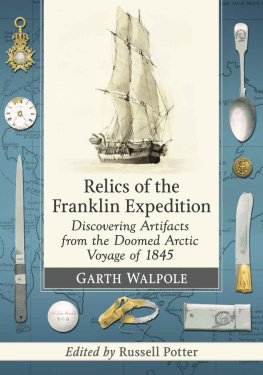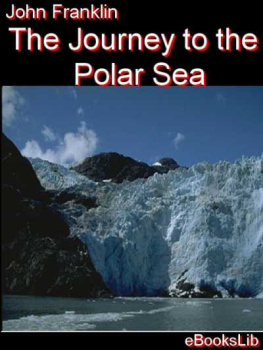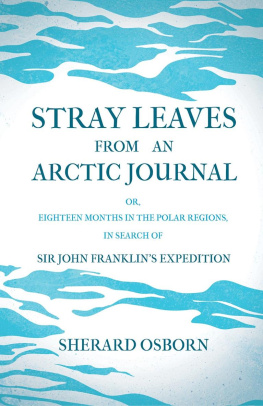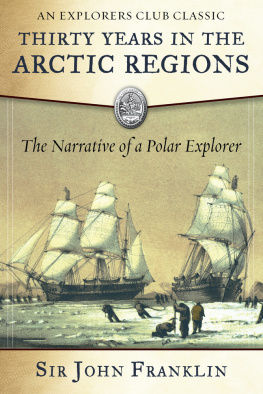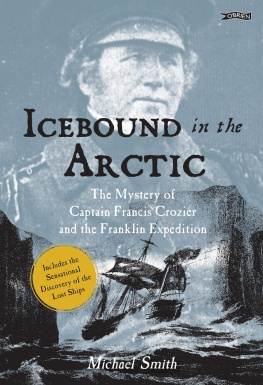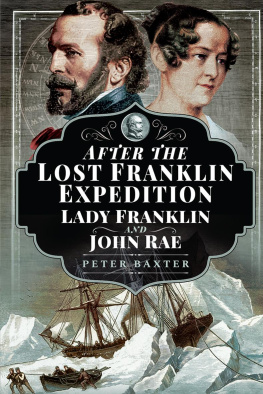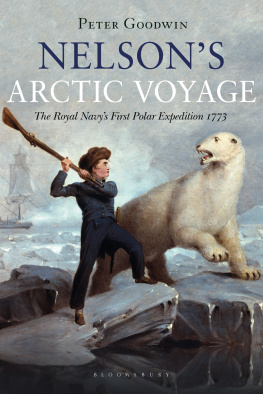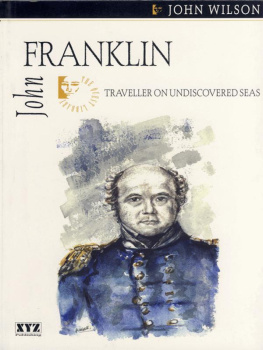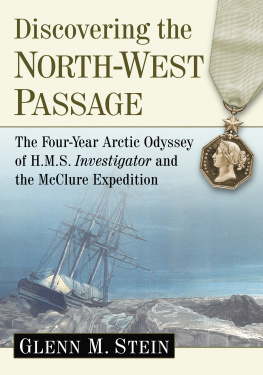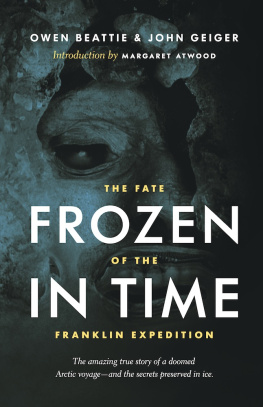Relics of the Franklin Expedition
Discovering Artifacts from the Doomed Arctic Voyage of 1845
Garth Walpole
Edited by Russell Potter

McFarland & Company, Inc., Publishers
Jefferson, North Carolina
e-ISBN: 978-1-4766-2712-0
LIBRARY OF CONGRESS CATALOGUING DATA ARE AVAILABLE
BRITISH LIBRARY CATALOGUING DATA ARE AVAILABLE
2017 The Estate of Garth Walpole. Preface Russell A. Potter. All rights reserved
No part of this book may be reproduced or transmitted in any form or by any means, electronic or mechanical, including photocopying or recording, or by any information storage and retrieval system, without permission in writing from the publisher.
On the cover: The H.M.S. Erebus, sketched by Owen Stanley on June 4, 1845 (National Library of Australia 962202); Franklin Relics Brought by Dr. Rae, from W.W. Mays A Series of Fourteen Sketches Made during the voyage up Wellington Channel in search of Sir John Franklin, KCH, and the missing crews of H. M. discovery ships Erebus and Terror London 1855 (Doug Wamsley)
McFarland & Company, Inc., Publishers
Box 611, Jefferson, North Carolina 28640
www.mcfarlandpub.com
Acknowledgments
With thanks to Ali, whose support and times of long suffering as a history with an archaeology widow must be acknowledged.
To my mother, Patricia, for her faith, love, encouragement and never giving up on me.
Barbara Tomlinson (curator of antiquities) at the National Maritime Museum, who took the time to aid in researching for this study.
To Kristjn Ahronson, the original supervisor of my dissertation at Bangor, for his enthusiasm and for being willing to ask the hard questions. Special thanks to the tutorial staff at Bangor University for their exemplary encouragement and the library staff, who made the search for books, journals and hard to find articles easier.
In special memory of my study buddies Gina, Doreen, and Aled Jones, who were a great source of encouragement and who have joined the great cloud of witnesses (Hebrews 12:1).
To the memory of the crews of HMS Erebus and HMS Terror, particularly Francis Crozier, who might conceivably have been the last man standing; Goodsir and John Irving, the only ones to have returned to England; and to all those involved in the search for the Franklin crew. And finally to the memory of Sir John and Lady Jane Franklin, whose single-mindedness, courage, devotion and love for each other remain an inspiration. Hopefully, they will now be reunited.
Garth Walpole (19612015)
First and foremost, I want to thank the late Garth and Alison Walpole for the remarkable trust they have placed in me by asking me to prepare Garths manuscript for publication. Its been an enormous privilege and responsibility, butaided by their generosity in passing along Garths books and notesit has also been a distinct pleasure.
Im grateful as well to Douglas Wamsley and Kenn Harper for their great generosity in making available dozens of images from their collections, without which it would have been utterly impossible to properly illustrate this book. And to all the members of the Remembering the Franklin Expedition Facebook page, who were a constant source of support for Garth during his life, and of this book after his passing, I owe an incalculable debt. Special thanks go to Regina Koellner, Andrs Paredes Salvador, Peter Carney, William Greenwell, Jonathan Dore, Russ Taichman, and Wolfgang Opel, whose generous support covered the cost of those images for which reproduction fees were required.
Russell Potter
Table of Contents
Abbreviations Used
ILNIllustrated London News
NLANational Library of Australia
NMMNational Maritime Museum (Greenwich)
NMSNational Museum of Scotland
PROPublic Record Office
RNERoyal National Exhibition
RNMRoyal Naval Museum
RUSIRoyal United Service Institute (former Museum)
SPRIScott Polar Research Institute (Cambridge)
Editors Preface
Once upon a time, there was a man who yearned with all his heart to explore the secrets of the Arctic regions. The journey thence would be arduous, and there was no way to avoid its hazards, no way to make contact once it was begun. And yet, despite all these perils, his wife stood waving at the pier, wishing him fair winds and a following sea, as he departed for what would be the final time, never to be seen again. Years passed. And then, at last, after long waiting, she herself departed to seek him in the realms of light. Readers will, I suspect, recognize the familiar elements of the story of Sir John Franklin and his wife, Janeand yet there is another pair, another explorer and another faithful companion: Garth Walpole and his wife, Alison.
I first met Garth via the Remembering the Franklin Expedition Facebook group, established in 2008 by Lee Preston. Garth was one of the first to join, and even amidst the many enthusiastic Franklinites who formed the core of the group, Garth stood out. He was generous with what he had, eager to obtain articles and imagery that he didnt, and lively in the occasional, nearly real-time exchanges that were thenand still area feature of the site. Through these discussions, I learned a bit more about Garth: he had been born in Hobart, Tasmania, known for its large public statue of Franklin, not far from Government House, where Sir John had once served as the colonys Lieutenant-Governor. Garth, from what I understood, had always had a fascination with the past, but it was only later in life that the Franklin story became for himas it was for all of ussuch a delightfully persistent obsession.
Working on his archaeology degree, hed written a thesis on the Franklin relics that he was expanding to book length; hed shared some sections with me, as Id shared sections of my own ongoing work. He was always especially eager to obtain new images of the relics, or resolve discrepancies in the archival records about them, and he and I would often exchange messages on such questions. And, when word of the discovery of Franklins first ship got out, Garth had a strong intuition that it was the Erebus, not the Terror, but I wagered against him, telling him Id eat my hat if I were wrong. And of course, he was rightI can still recall the taste of felt (though, in the interest of avoiding indigestion, a symbolic nibble had to make do for the whole). Along with the rest of usperhaps more than any of ushe reveled in that discovery, and it energized his work.
None of us had known, though, that he was already ill. It wouldnt have been like Garth to say much about it; I imagine that he must have been a fairly private person, and didnt want to be the recipient of online sympathy. And so we didnt know, until Alison posted a note to the group, letting us know that he was in the final stages of his illness and expressing his thanks for the companionship and encouragement hed received from the group. Of course, we all responded with the same feeling, sharing our sense of gratitude and loss, and it was a comfort to know that Ali (as we came to know her) had passed along our regards. It came as a shock, though, how quickly the end came, and Garth was no longer among us. I am certain that no member of the group from that time will ever forget him.
It was just a few weeks after Garths passing that I received an e-mail from Ali, in which she told me that Garth had in fact nearly finished the book which had been so much at the center of his final years. Not only that, but he had hoped that I might be able to complete the needed work, and find some way to bring it to the attention of a publisher. Garth had also left instructions that his library of Franklin books should be sent to me to enable me to check his references, scan images, and finish compiling his bibliography. And, at last, I agreed, and so two fifty-pound crates of books arrived from Australianot only a remarkable collection, but, as I found when paging through them, one crammed full of Garths notes and bookmarks, leaving a fresh trail of breadcrumbs for me to follow.

